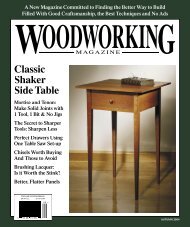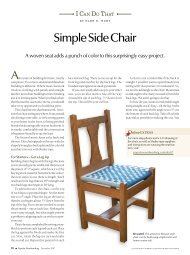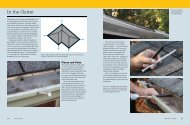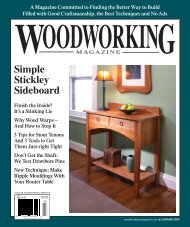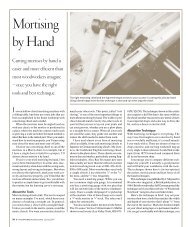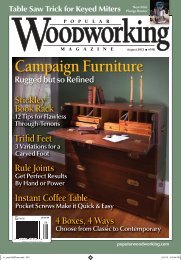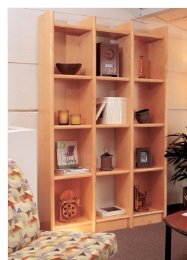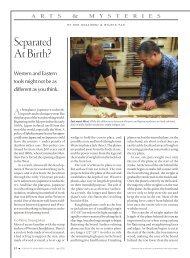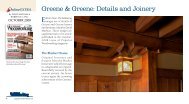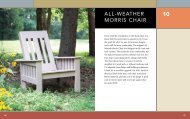Classic Shaker Side Table - Popular Woodworking Magazine
Classic Shaker Side Table - Popular Woodworking Magazine
Classic Shaker Side Table - Popular Woodworking Magazine
- No tags were found...
Create successful ePaper yourself
Turn your PDF publications into a flip-book with our unique Google optimized e-Paper software.
tised piece too much and crowned the surface,the shoulder can be chiseled up near the cheek toeliminate any gap that might appear between thejoint’s pieces. The shoulder is therefore necessaryonly on surfaces that show on the final project.There’s something else to consider when makingshoulders: If you make them too wide, youcan introduce two problems to your joint. First,bigger shoulders means you have smaller cheeks,which reduces the overall strength of the joint.Second, a large shoulder will allow the tenonedboard to cup or bow slightly at its edges. Big shoulderscan, over time, result in a joint that isn’t flushlike it was the day you made it.Fewer Shoulders Make it EasierWith all these parts to keep track of, it’s no wonderthat some woodworkers shy away from this joint.But tenons for tables can be simpler than tenonsfor other assemblies. Here’s why: The tenons fortables need fewer shoulders. Really, only one faceof the apron shows in a table. You definitely don’tneed a shoulder on the inside of the apron.A shoulder at the bottom of the apron is optional,though a very small one is easy to fit andprevents the apron from cupping.And here’s the real kicker – you don’t need ashoulder at the top of the apron. In fact, I’d arguethat eliminating it can make a better joint for tworeasons: First, because the tenon is almost thefull width of the apron, it keeps your apron fromcupping or bowing. This is especially importantin a table because a cupped apron can push thetabletop up in places, spoiling its flatness. Second,it makes the mortise easy to cut. Essentially themortise is stopped only at one end. As you’ll seeshortly, this allows you to make this joint withouta lot of equipment.Of course, the logical objection to a joint likethis is that if the mortise is open on one end thenthe table won’t resist racking. I argue that a properlyfitted tabletop takes the place of that mortisewall, constraining the tenon’s edge cheekand keeping it from racking. And, as you’ll seelater, you can easily reinforce this joint with awell-placed peg for added insurance.Choosing Your ToolsOne big objection to mortise-and-tenon joineryis the specialized tools you need to make it.Benchtop mortising machines cost $200; a kitthat allows your drill press to serve as a makeshiftmortiser costs about $70 (assuming you have adrill press). An option is to cut your mortises witha plunge router and a shopmade or commercial jig($75 or so). But these jigs take time and moneyand aren’t necessary for this particular joint.For cutting the tenons, you could buy a commercialjig, build a tenoning jig or get a dado stack($85 for starters) to do the job on the table saw.Still other woodworkers insist on cutting thejoint by hand. I do a lot of handwork, but makingCheeksShouldersThe anatomy of a typicaltenon with four shoulders.Faceshoulderthis joint with hand tools requires an investmentin tools (tenon saw, carcase saw, mortising chiseland shoulder plane) and practice time. Whilethere is pleasure in cutting this joint by hand, itcan be frustrating at first. (See “Cutting this Jointwith Hand Tools” on page 8.)There is an easier way. I argue that you cando all the mortise-and-tenon joinery for a simpletable with a router, a router table and a 3 ⁄ 8 "-diameter straight bit. All three items are commonequipment in even the most bare-bones shop.In a nutshell, here’s how it’s done: First millyour mortises in the legs. Set up the straight bitin your router table and set the fence to center thecut on the width of the leg. Cut the mortise outin several passes, increasing the height of the bitwith each pass. You’ll need a stop on the outfeedside of the router table’s fence to stop the mortisein the same location.To cut the tenons, keep that same bit in yourrouter table and use a miter gauge (or a scrap ofwood) to guide the apron into the bit, cutting arabbet on each end. Adjust the height of the bituntil the tenon fits perfectly in its mortise.The heart of this method is the 3 ⁄ 8 "-diameterstraight bit. Why 3 ⁄ 8 "? There are several reasons.Aprons for small tables are typically going to bemade using 3 ⁄ 4 "-thick wood, and tenons as a ruleare supposed to be half as thick as the stock they’re“Any intelligent fool can make thingsbigger, more complex, and moreviolent. It takes a touch of genius –and a lot of courage – to movein the opposite direction.”— E.F. Schumacher (1911 - 1977)author of “Small is Beautiful”FacecheekEdgeshoulderEdgecheekThe shoulders cover up any inaccuracy in the mortises of thesebare-faced tenons with simple shoulders.BWhen tenons are closer to the outside of theaprons, as in example “B” above, they can haveextra length, compared to the tenons in example“A” that are centered on the aprons.cut on. This makes a balanced joint: half of it istenon and the other half is shoulder.But some woodworkers use 1 ⁄ 4 "-thick tenonson 3 ⁄ 4 " stock. For this particular technique, I thinkthat’s a mistake. Straight bits that are 1 ⁄ 4 " diameterare fragile; even quality ones will snap easily ifyou put too much pressure on them. Similarly, abeefy 1 ⁄ 2 "-diameter straight bit is also a bad idea.You could use one, but then your mortise starts toget so wide that its walls can become more fragile,especially in a small table’s delicate legs. I’dsave the 1 ⁄ 2 " bit for milling joints for bigger projects,such as dining tables.The router doesn’t have to be fancy – even alow-powered single-speed tool will do this jobwith relative ease. And the router table doesn’thave to be expensive, either. Any table with anadjustable fence will do – even a shop-made versionwith a simple plywood table and a straightscrap of solid wood for the fence.Awoodworking-magazine.com ■ 7



